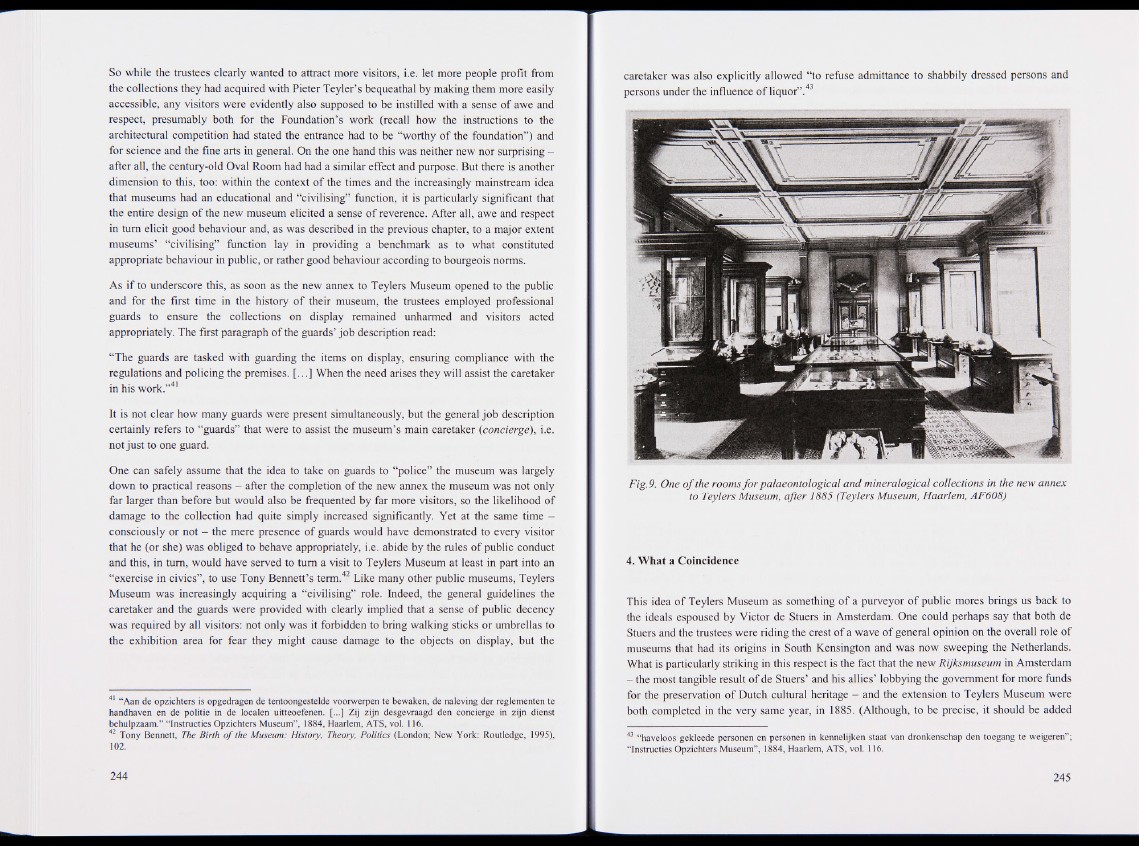
So while the trustees clearly wanted to attract more visitors, i.e. let more people profit from
the collections they had acquired with Pieter Teyler’s bequeathal by making them more easily
accessible, any visitors were evidently also supposed to be instilled with a sense of awe and
respect, presumably both for the Foundation’s work (recall how the instructions to the
architectural competition had stated the entrance had to be “worthy of the foundation”) and
for science and the fine arts in general. On the one hand this was neither new nor surprising -
after all, the century-old Oval Room had had a similar effect and purpose. But there is another
dimension to this, too: within the context of the times and the increasingly mainstream idea
that museums had an educational and “civilising” function, it is particularly significant that
the entire design of the new museum elicited a sense of reverence. After all, awe and respect
in turn elicit good behaviour and, as was described in the previous chapter, to a major extent
museums’ “civilising” function lay in providing a benchmark as to what constituted
appropriate behaviour in public, or rather good behaviour according to bourgeois norms.
As if to underscore this, as soon as the new annex to Teylers Museum opened to the public
and for the first time in the history of their museum, the trustees employed professional
guards to ensure the collections on display remained unharmed and visitors acted
appropriately. The first paragraph of the guards’ job description read:
“The guards are tasked with guarding the items on display, ensuring compliance with the
regulations and policing the premises. [...] When the need arises they will assist the caretaker
in his work.” 1
It is not clear how many guards were present simultaneously, but the general job description
certainly refers to “guards” that were to assist the museum’s main caretaker (concierge), i.e.
not just to one guard.
One can safely assume that the idea to take on guards to “police” the museum was largely
down to practical reasons — after the completion of the new annex the museum was not only
far larger than before but would also be frequented by far more visitors, so the likelihood of
damage to the collection had quite simply increased significantly. Yet at the same time -
consciously or not - the mere presence of guards would have demonstrated to every visitor
that he (or she) was obliged to behave appropriately, i.e. abide by the rules of public conduct
and this, in turn, would have served to turn a visit to Teylers Museum at least in part into an
“exercise in civics”, to use Tony Bennett’s term.42 Like many other public museums, Teylers
Museum was increasingly acquiring a “civilising” role. Indeed, the general guidelines the
caretaker and the guards were provided with clearly implied that a sense of public decency
was required by all visitors: not only was it forbidden to bring walking sticks or umbrellas to
the exhibition area for fear they might cause damage to the objects on display, but the
41 “Aan de opzichters is opgedragen de tentoongestelde voorwerpen te bewaken, de naleving der regiementen te
handhaven en de politie in de localen uitteoefenen. [...] Zij zijn desgevraagd den concierge in zijn dienst
behulpzaam.” “Instructies Opzichters Museum”, 1884, Haarlem, ATS, vol. 116.
Tony Bennett, The Birth o f the Museum: History, Theory, Politics (London; New York: Routledge, 1995),
102.
caretaker was also explicitly allowed “to refuse admittance to shabbily dressed persons and
persons under the influence of liquor”.43
Fig. 9. One o f the rooms for palaeontological and mineralogical collections in the new annex
to Teylers Museum, after 1885 (Teylers Museum, Haarlem, AF608)
4. What a Coincidence
This idea of Teylers Museum as something of a purveyor of public mores brings us back to
the ideals espoused by Victor de Stuers in Amsterdam. One could perhaps say that both de
Stuers and the trustees were riding the crest of a wave of general opinion on the overall role of
museums that had its origins in South Kensington and was now sweeping the Netherlands.
What is particularly striking in this respect is the fact that the new Rijksmuseum in Amsterdam
- the most tangible result of de Stuers’ and his allies’ lobbying the government for more funds
for the preservation of Dutch cultural heritage gland the extension to Teylers Museum were
both completed in the very same year, in 1885. (Although, to be precise, it should be added
43 “haveloos gekleede personen en personen in kennelijken staat van dronkenschap den toegang te weigeren” ;
“Instructies Opzichters Museum”, 1884, Haarlem, ATS, vol. 116.